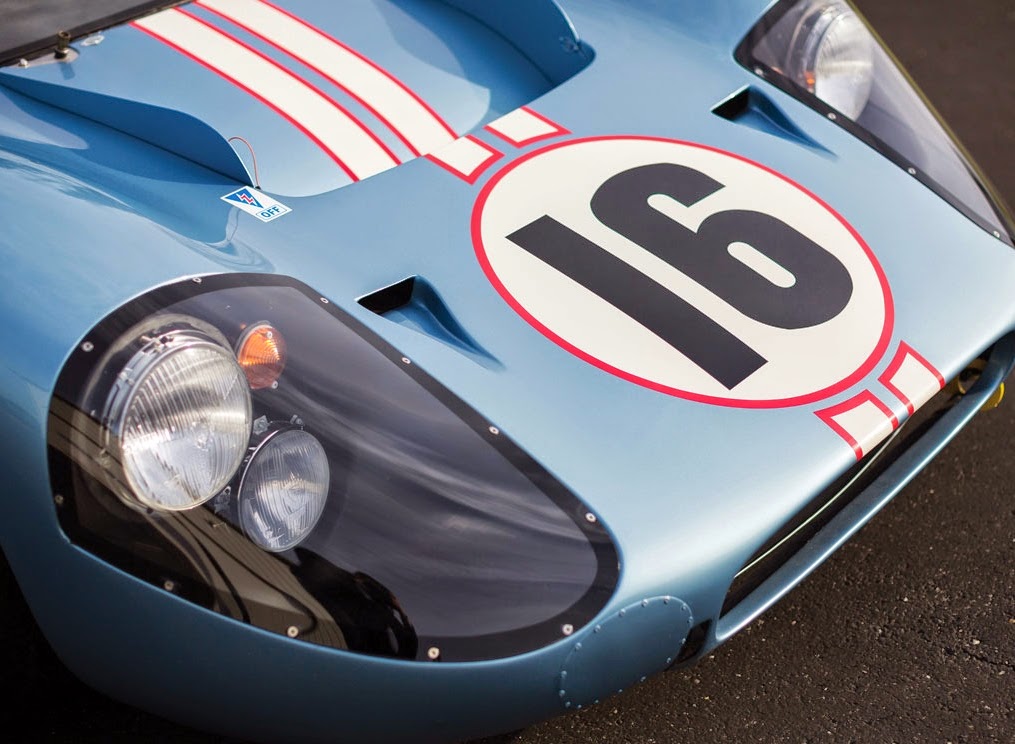Ford only built 12 GT40 Mk IVs, but the team at Kar Kraft is building a limited run of 7 continuation cars that are legal to race in HSR and SCRA and it comes with an FIA Historic Technical Passport for competition in Europe. This the price of original GT40's in the stratosphere these continuation cars are becoming more common at the historic races, not that this car is going to be a price of an Aztec GT, but it still significantly less than a real GT40 if you are looking for a car for the track. This car is offered next January at the RM Auctions Phoenix Sale Click HERE for the official listing.
Official Catalog Description:
500 bhp, 427 cu. in. V-8 engine with dual four-barrel Holley carburetors, model T-44 four-speed manual transaxle, front and rear independent suspension with coil springs and shock absorbers, and four-wheel ventilated disc brakes. Wheelbase: 95 in.
The fourth of only seven continuation Mk IV GT40s
A faithful recreation of one of the most important American cars ever built
As history would reveal, the Mk IV would only be campaigned in two races, at the 1967 12 Hours of Sebring, where Mario Andretti and Bruce McLaren piloted an Mk IV to victory, and at the 1967 24 Hours of Le Mans, where Dan Gurney and A.J. Foyt outperformed all to the checkered flag and won the Index of Performance for the most efficient car. That victory is the only all-American outright win of an American-built chassis, engine, team, and drivers at the fabled Le Mans 24-hour endurance race. Due to the Mk IV’s unparalleled performance, the FIA quickly relegated the Mk IV to racing extinction by outlawing any prototype car that had larger than three-liter motors.
As such, advice and documentation (including a set of original Kar-Kraft engineering drawings) was gathered from many involved in the original Mk IV program, such as Carroll Shelby, Edsel Ford II, Dan Gurney, Carroll Smith, Phil Remington, Roy Lunn, Chuck Mountain, Ed Hull, Homer Perry, Ray Geddes, and many more. The Kar-Kraft team also included Ken Thompson, a fabricator at Holman and Moody’s shops in the 1960s, when the Mk IVs campaigned, and a recipient of NASCAR’s Fabricator of the Year award not once but twice. The construction process spanned eight years to achieve the result presented here. Make no mistake, these cars were built as mirror images of the originals, as they were constructed with a honeycomb-aluminum riveted and bonded chassis and fitted with fiberglass bodywork. Each car was graced with a 427-cubic inch V-8 that was capable of producing 500 horsepower, just like the originals.
Chassis J-16 was finished in Princess Blue with white stripes and red and blue accents, in tribute to Shelby’s early Cobras, and it also retained roundels on the nose and doors and dual racing stripes, which were similar to the Mk IVs that competed at Le Mans in 1967, J-5 and J-6. It completed construction in the final days of 2010, alongside the other Kar Kraft Mk IV GT40s, and it was built for Joe Henderson, of Ashville, North Carolina. It is the fourth of seven continuation cars built, and it is the sole example finished in this particular livery. Chassis J-16 is faithfully equipped with a dual-quad, dual-plane, 427-cubic inch tunnel-port V-8 that is capable of producing 500 horsepower and provides rotation force through the magnesium-cased T-44 transaxle, which was designed specifically for the GT program. The car was entered in just one vintage race, to work out any potential issues, and it is legal to race in HSR and SCRA events. It also comes with an FIA Historic Technical Passport for competition in Europe.









_websize.jpg)









